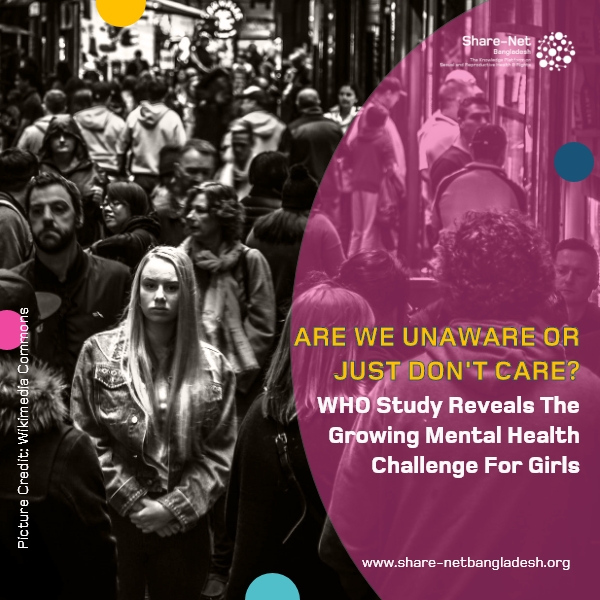Are We Unaware Or Just Don’t Care? WHO Study Reveals the Growing Mental Health Challenge for Girls
Those who are wondering what’s the meaning of the question in the title, here is the explanation based on a recent study by the WHO. The mental health of girls worldwide is in crisis, with over half experiencing psychosomatic complaints weekly. These issues, linked to SRHR, have worsened post-COVID-19, emphasising the need for urgent attention.
The mental health of girls around the globe is deteriorating at an alarming rate. According to a large-scale study by the World Health Organization (WHO), 56% of girls aged 11 to 16 now experience psychosomatic complaints, such as insomnia, headaches, and depression, more than once a week.
This is a significant increase from 2017, where the figure stood at 43%. These psychosomatic issues, which often have psychological origins, are deeply intertwined with sexual and reproductive health and rights (SRHR) and the broader goals of sustainable development.
Lead researcher Gonneke Stevens from the Netherlands highlights that the mental health crisis among girls is severe even in her home country, although not as dire as the global situation. In the Netherlands, 50% of girls reported such complaints in 2022, up by 18 percentage points from 2017.
The study underscores the immense pressure girls face from schoolwork and the lingering effects of the COVID-19 pandemic. The disruption of social interactions during the pandemic has had a lasting impact, particularly on girls, who rely more heavily on physical social connections than boys.
Addressing the mental health of young girls is crucial for achieving the United Nations Sustainable Development Goals (SDGs), particularly those related to health and well-being (SDG 3) and gender equality (SDG 5). Positive social relationships are vital for mental well-being, and initiatives that foster these connections can significantly contribute to the mental health of young people.
Social relationships play a pivotal role in the mental health of young people. Stevens emphasises the importance of maintaining positive social ties with parents, friends, and classmates. Despite the challenges, Dutch youths seem to be faring relatively well due to their ability to form and maintain these crucial connections. Programs and institutions like the Museum of the Mind in Haarlem and Amsterdam provide platforms for young people to engage and discuss mental health openly through art and social activities.
The Museum of the Mind offers specialised art routes aimed at making mental health a topic of conversation. Program director Jessica Belles mentions that artworks, such as a meter-high painting of a pink elephant, symbolise mental health issues that are often ignored. Volunteering at the museum has provided opportunities for teenagers like Leia, who struggle with anxiety and panic attacks, to reintegrate into society and pursue their interests, such as photography.
The Dutch Center for Youth Health (NCJ) has also developed educational programs about mental health, with their initiative “Je Brain de Baas?! (Your Brain is the Boss?)” being adopted by nearly 5,000 schools. These programs are designed with input from students, ensuring that their voices are heard and their needs are addressed.
While intensive social media use is a concern globally, Dutch teenagers score the lowest on problematic use internationally. This suggests a balanced approach to social media that can serve as a model for other countries. However, the overall picture remains concerning, with a significant portion of girls experiencing mental health issues.
Stevens remains optimistic about the resilience of Dutch youth, citing their strong social relationships and trust bonds. Nonetheless, she acknowledges the critical need for continued efforts to improve the mental health of girls, both in the Netherlands and across Europe.
Improving the mental health of girls is not just a national issue but a global one, integral to the advancement of SRHR and achieving the SDGs. By fostering positive social environments and addressing the underlying causes of stress and anxiety, societies can work towards better mental health outcomes for future generations.
Now that we have learned the situation, another question arises – Are we willing to start caring for the mental health of our girls? If yes, then we must foster supportive environments, implement mental health programs, and address unnecessary social pressures. And if not, then Que Sera Sera! Ignoring this will lead to a generation struggling with mental health. Now, the choice is ours to make.
Source: NOS – The Nederlandse Omroep Stichting (Dutch Broadcasting Foundation)
Picture Credit: Wikimedia Commons



